
Ficaria verna, commonly known as lesser celandine or pilewort, is a low-growing, hairless perennial flowering plant in the buttercup family Ranunculaceae. It has fleshy dark green, heart-shaped leaves and distinctive flowers with bright yellow, glossy petals. Native to Europe and Western Asia, it is now introduced in North America, where it is known by the common name fig buttercup and considered an invasive species. The plant is poisonous if ingested raw and potentially fatal to grazing animals and livestock such as horses, cattle, and sheep. For these reasons, several US states have banned the plant or listed it as a noxious weed. It prefers bare, damp ground and is considered by horticulturalists in the United Kingdom as a persistent garden weed; nevertheless, many specialist plantsmen, nursery owners and discerning gardeners in the UK and Europe collect selected cultivars of the plant, including bronze-leaved and double-flowered ones. Emerging in late winter with flowers appearing late February through May in the UK, its appearance across the landscape is regarded by many as a harbinger of spring.

Ranunculaceae is a family of over 2,000 known species of flowering plants in 43 genera, distributed worldwide.

Ranunculus is a large genus of about 1700 to more than 1800 species of flowering plants in the family Ranunculaceae. Members of the genus are known as buttercups, spearworts and water crowfoots.
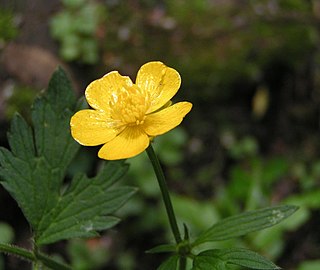
Ranunculus repens, the creeping buttercup, is a flowering plant in the buttercup family Ranunculaceae, native to Europe, Asia and northwestern Africa. It is also called creeping crowfoot and sitfast.

Ranunculus bulbosus, commonly known as bulbous buttercup or St. Anthony's turnip, is a perennial flowering plant in the buttercup family Ranunculaceae. It has bright yellow flowers, and deeply divided, three-lobed long-petioled basal leaves.
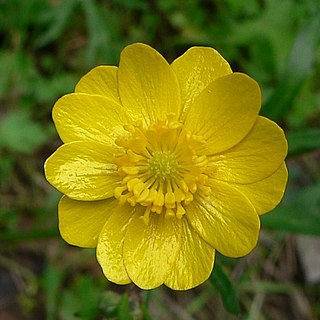
Ranunculus californicus, commonly known as the California buttercup, is a flowering plant of the buttercup family Ranunculaceae. It is a native of California, where it is common in many habitats, including chaparral and woodlands.
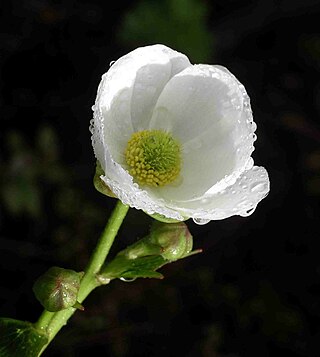
Ranunculus lyallii, is a species of Ranunculus (buttercup), endemic to New Zealand, where it occurs in the South Island and on Stewart Island at altitudes of 700–1,500 m. R. lyallii is the largest species in the genus Ranunculus, growing over a metre in height.

Ranunculus glaberrimus, the sagebrush buttercup, is a species of flowering plant in the buttercup family, Ranunculaceae. It is native to interior western North America, in western Canada, the western United States, and the northwestern Great Plains.

Ranunculus pusillus, commonly called low spearwort, is a species of flowering plant in the buttercup family (Ranunculaceae). It is native to much of the eastern United States from New York to Florida and west to Texas; it is also known in California. It grows in wet habitat, where it is semi-aquatic growing partially submerged or terrestrially on muddy substrates.
Ranunculus allenii, commonly known as Allen's buttercup, is a flowering plant in the crowfoot or buttercup family, Ranunculaceae. Generally found in wetlands in northern latitudes, it bears yellow flowers in summer, which are pollinated by insects.
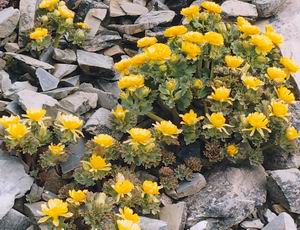
Ranunculus acraeus is a species of flowering plant in the buttercup family, Ranunculaceae, found in New Zealand. This rare and native species strictly grows on an alpine habitat, hence the name acraeus, meaning “on high”. The plant grows about 50 cm (20 in) in width, and is covered in beautiful, bright yellow flowers. It may be mistaken for R. piliferus but research has shown R. acraeus to be its own distinctive species.
Solms-laubachia himalayensis is a flowering plant in the family Brassicaceae. The specific epithet himalayensis is from the Latin, meaning "Himalayan".

Ranunculus hispidus is a species of perennial flowering plant in the buttercup family, Ranunculaceae. It is commonly known as bristly buttercup or hispid buttercup. It is a small plant native to central and eastern North America that grows to a height up to 30 cm (1 ft) and has 5-petaled yellow flowers.
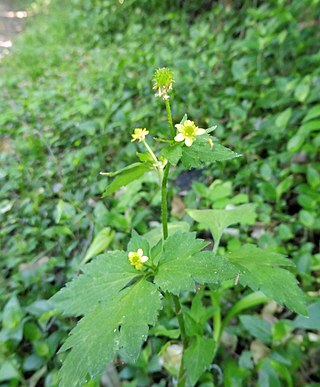
Ranunculus silerifolius is a species of flowering plant in the buttercup family (Ranunculaceae). It is native to eastern Asia, where it is found in Bhutan, China, northeast India, Indonesia, Japan, and Korea. Its natural habitat is in moist places, by steams, in forests, or on grassy slopes. It is considered a common species in Japan, and can be found in disturbed areas.
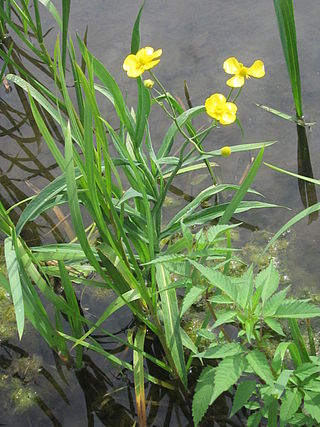
Ranunculus lingua, the greater spearwort, great spearwort, tongue-leaved crowfoot, or water buttercup, is a plant species in the family Ranunculaceae native to temperate areas of Europe, Siberia and through to the western Himalayas. It is a semiaquatic plant that prefers to grow in about 40 cm (16 in) of water in a variety of wetland habitats. A cultivar called 'Grandiflorus', the large-flowered greater spearwort, has 6 cm flowers and is favored by gardeners.
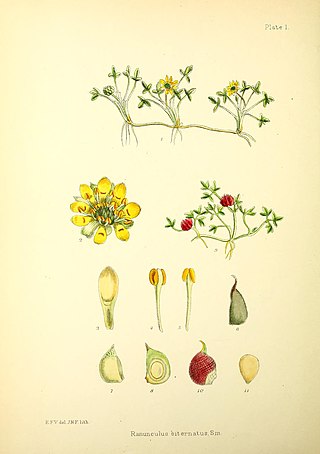
Ranunculus biternatus, the Antarctic buttercup, is a plant in the buttercup family Ranunculaceae. It is native to southern South America and some subantarctic islands.
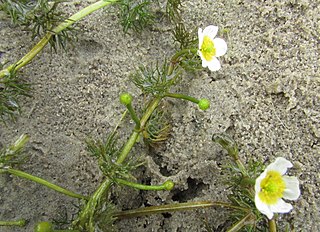
Ranunculus kauffmannii is a species of flowering plant belonging to the family Ranunculaceae.
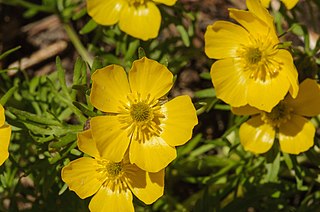
Ranunculus adoneus, the alpine buttercup or snow buttercup, is a species of flowering plant. It is an alpine buttercup from the family Ranunculaceae. This species is mainly found in the Rocky Mountains in Colorado and Wyoming but can also be found in Idaho, northern Utah and eastern Nevada. Its typical habitat is short grass meadows near the edge of melting snow.

Ranunculus pimpinellifolius, commonly known as bog buttercup, is a flowering plant in the family Ranunculaceae and grows in eastern Australia. It is a low growing perennial with divided green leaves and yellow flowers.

Ranunculus baudotii, brackish water-crowfoot, is a flowering plant in the Ranunculaceae. As the name suggests, it tends to grow near the sea, typically in pools and ditches in coastal marshes that are slightly salty due to sea spray. It can also be found inland where there is some saline influence. It is not edible and has economic uses, but it is generally valued as a plant of conservation interest and an indicator of less agriculturally improved habitat.

















